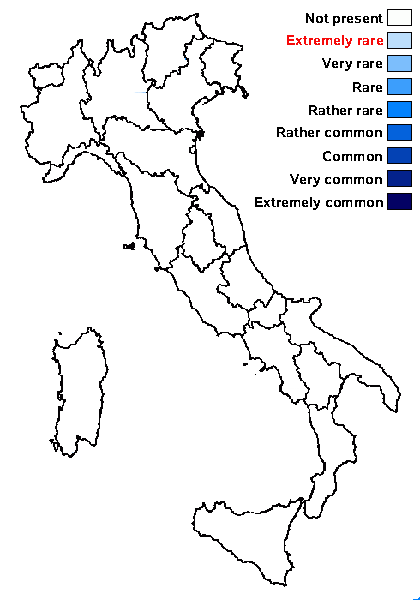Vezdaea dawsoniae Döbbeler
Herzogia 5, 1-2: 96, 1979
Synonyms:
Distribution:
Description: Thallus crustose, thin and filmy, hardly visible, brownish, minutely granular but without goniocysts, doubtfully lichenized. Apothecia short-lived, without a proper margin, single, 0.3-1 mm across, turbinate when young, distinctly stalked when mature , the stipe 20-30 µm thick, composed of subparallel hyphae (apothecia recalling those of a minute calicioid lichen), the disc becoming convex to globose, pale flesh-coloured to orange-brown. Proper exciple absent; hymenium lacking gelatine, consisting of asci which are sometimes intermixed with a few, slender, branched and anastomosing paraphyses confined to the lower part of hymenium, not entwining the asci. Asci 8-spored, cylindrical, thick-walled, with a thick I+ blue apex (except for an apical pore), 29-33 x 10-15 μm. Ascospores 1-septate,with slightly unequal cells, hyaline, narrowly ellipsoid, (13-)15-18 x 3-4 μm, with rounded ends and a smooth wall. Photobiont perhaps absent or chlorococcoid. Spot tests: all negative. Chemistry: without lichen substances.Note: a species resembling V. stipitata, based on a type from Papua New Guinea and reported from the Caucasus and the French Alps (conspecificity of European specimens in need of re-evaluation), growing on leaves and on the uppermost parts of branches of evergreen shrubs (e.g. Buxus) in the understory of broad-leaved forests in very humid, winter-mild sites.
Growth form: Crustose
Substrata: bark and leaves
Photobiont: green algae other than Trentepohlia
Reproductive strategy: mainly sexual
Most common in areas with a humid-warm climate (e.g. most of Tyrrenian Italy)

Predictive model
Growth form: Crustose
Substrata: bark and leaves
Photobiont: green algae other than Trentepohlia
Reproductive strategy: mainly sexual
Most common in areas with a humid-warm climate (e.g. most of Tyrrenian Italy)

Predictive model
 INDEX FUNGORUM
INDEX FUNGORUM
 GBIF
GBIF

